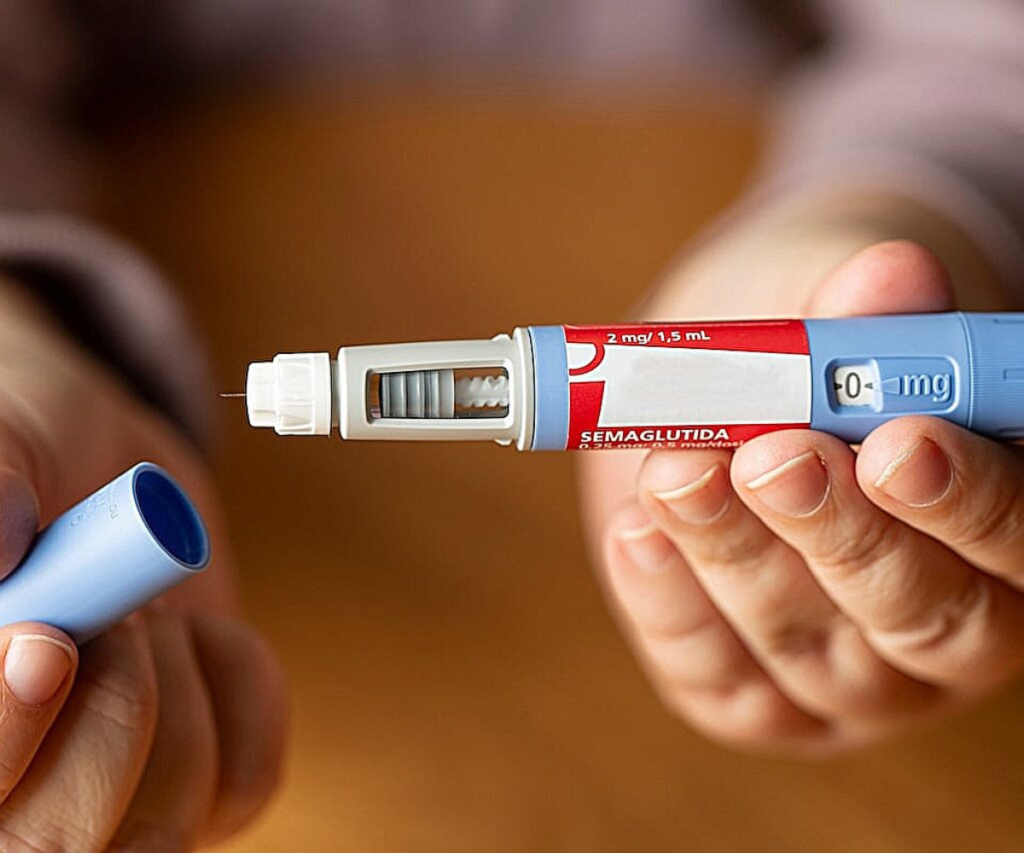A Deep Look at the Connection Between Semaglutide and Vision
Ozempic Eye Health has become a growing topic of concern as the diabetes medication semaglutide—sold under brand names such as Ozempic, Wegovy, and Rybelsus—continues to gain worldwide attention for helping manage type 2 diabetes and support weight loss. However, many experts and patients are now exploring how this drug might influence vision quality and long-term eye health.

This detailed article explores the connection between Ozempic and vision, explaining how semaglutide works in the body, what researchers have discovered about potential eye-related side effects, and how users can protect their eyes while benefiting from the medication.
Understanding Semaglutide: How It Works in the Body
Semaglutide is a GLP-1 receptor agonist, a medication that mimics the action of a natural hormone called glucagon-like peptide 1 (GLP-1). This hormone helps regulate blood sugar levels by:
- Triggering insulin release after meals
- Reducing glucose production by the liver
- Slowing digestion, helping individuals feel full longer
- Decreasing appetite and food intake
These combined effects lead to better blood sugar control and weight loss, making semaglutide a popular choice for people managing type 2 diabetes or obesity.
However, the same mechanisms that affect blood sugar can also influence vision, since the eyes are highly sensitive to even slight changes in glucose levels.
The Link Between Blood Sugar Fluctuations and Vision
The eyes rely on a delicate balance of fluids and oxygen. When blood sugar levels rise or drop sharply, it can change the shape and flexibility of the eye’s lens, temporarily affecting how light focuses on the retina.
This can result in blurred or fluctuating vision, particularly during the first few months of starting semaglutide. Such changes often stabilize once blood sugar levels remain consistent, but the initial adjustment period can be confusing or alarming for new users.
Older adults may notice these side effects more strongly, as the lens becomes less flexible with age, slowing the eyes’ ability to adapt to rapid blood-sugar changes.
Short-Term Visual Changes: What to Expect When Starting Ozempic
Many individuals report temporary vision issues shortly after beginning semaglutide therapy. These changes include:
- Blurred or hazy vision
- Eye fatigue or mild strain
- Sensitivity to bright light
- Difficulty focusing on nearby or distant objects
These effects are typically short-lived and may resolve within three to four months as the body adjusts to stabilized glucose levels. However, people who already have diabetic eye disease may experience a more noticeable reaction and should seek prompt evaluation if their vision worsens.
Can Ozempic Cause Permanent Eye Damage?
The question many ask is whether Ozempic or other semaglutide-based medications can cause long-term eye damage or vision loss.
While most patients experience only mild, reversible symptoms, there have been studies suggesting a potential connection between semaglutide and a rare condition called non-arteritic anterior ischemic optic neuropathy (NAION)—a type of optic nerve damage that can lead to sudden vision loss.
It is important to emphasize that the current research is inconclusive. The studies indicate a possible association, not proven causation. Individuals with diabetes are already at higher risk of NAION and other eye diseases, regardless of whether they use semaglutide.
At present, the medical community agrees that more research is needed before drawing firm conclusions. Until then, awareness and regular eye check-ups are key to early detection and prevention.
Diabetic Retinopathy and Semaglutide: Understanding the Concern

Diabetic retinopathy is one of the most common complications of long-term diabetes. It occurs when high blood sugar damages the tiny blood vessels in the retina, leading to fluid leaks, swelling, or abnormal new blood-vessel growth.
One of the paradoxes of diabetes management is that rapid improvement in blood sugar levels—such as that achieved by semaglutide—can sometimes temporarily worsen diabetic retinopathy.
Here’s why:
When blood sugar decreases quickly after years of being high, the fragile retinal blood vessels may respond unpredictably, sometimes leaking fluid or blood before they stabilize.
Most of the time, these symptoms are temporary and manageable, but they underline the importance of gradual glucose improvement and consistent eye examinations for anyone starting semaglutide therapy.
Early Warning Signs of Eye Complications
People using semaglutide should pay attention to subtle vision changes and report them promptly. Early signs of eye issues include:
- Persistent blurred vision
- Floating spots or dark patches
- Distorted or wavy lines
- Difficulty reading or seeing details
- Sudden flashes of light
- Unexplained eye pain or redness
Not all vision changes indicate serious problems, but early detection can prevent progression to irreversible conditions such as macular edema or retinal detachment.
How Semaglutide Affects Eye Blood Flow
Researchers continue to study how GLP-1 receptor agonists like semaglutide influence blood flow within the eye.
Preliminary evidence suggests that GLP-1 receptors are present in the retina and optic nerve, meaning these medications could theoretically alter local blood circulation or metabolic activity.
In some patients, improved systemic blood-sugar control may benefit the eyes by reducing inflammation and oxidative stress. In others—particularly those with pre-existing microvascular damage—rapid metabolic changes might cause temporary strain on the retinal vessels, triggering symptoms that resemble worsening diabetic retinopathy.
The overall outcome appears to depend on individual health factors, including age, duration of diabetes, and baseline eye condition.
Is There a Risk of Blindness?
At this point, there is no solid proof that Ozempic directly causes blindness. The majority of users do not experience severe vision problems.
However, people with advanced diabetes or untreated retinopathy are inherently at risk of vision loss, with or without semaglutide. The safest approach is to treat the medication as one factor in a larger health equation—a tool that should be monitored carefully rather than feared outright.
Protecting Eye Health While Using Ozempic
To safeguard vision while taking semaglutide, follow these key strategies:
- Schedule regular eye exams. Adults with diabetes should have a full dilated eye exam at least once a year, or more frequently if advised.
- Monitor blood sugar carefully. Avoid sudden, dramatic drops; gradual improvement is safer for your eyes.
- Stay hydrated and eat nutrient-rich foods. Vitamins A, C, E, zinc, lutein, and omega-3 fatty acids support retinal health.
- Report changes immediately. Blurred or distorted vision that lasts more than a few days should be evaluated by an eye-care professional.
- Balance lifestyle habits. Combine medication with healthy diet, exercise, and proper sleep to reduce systemic inflammation.https://www.youtube.com/watch?v=O4MwcKkMlzk
Should Ozempic Be Used for Weight Loss Alone?

While Ozempic has become popular for weight loss, it was originally developed to treat diabetes. Off-label use purely for aesthetic goals has raised ethical and medical questions.
Weight loss achieved through semaglutide occurs because it reduces appetite and slows gastric emptying, helping users feel full with less food. Although these effects can promote sustainable weight reduction, they may also cause nutritional deficiencies if not managed properly.
Health experts recommend that individuals considering Ozempic for weight management should consult their physician, undergo metabolic assessment, and use the medication under supervision to minimize risks to the eyes and other organs.
Lifestyle Habits That Support Both Vision and Metabolic Health
Medication works best when combined with holistic habits that support long-term wellness. The following lifestyle practices protect both your eyesight and your overall health:
- Eat colorful produce. Carrots, spinach, kale, and oranges are rich in antioxidants.
- Exercise regularly. Physical activity improves blood circulation to the eyes and reduces diabetic risk.
- Limit processed sugars. Stable glucose levels prevent vascular damage in the retina.
- Quit smoking. Tobacco smoke accelerates oxidative stress and weakens blood vessels.
- Get adequate sleep. The eyes repair themselves during rest; chronic fatigue can worsen inflammation.
These changes complement semaglutide therapy, reducing side effects while enhancing its benefits.
What Ongoing Research Is Exploring
Large-scale studies continue to investigate how semaglutide affects diabetic eye complications. The upcoming FOCUS trial, expected to conclude in the next few years, aims to evaluate whether long-term use of GLP-1 receptor agonists influences the progression of diabetic retinopathy. Ozempic Eye Health.
Researchers are also studying the protective potential of these medications, as some early data suggest they might reduce oxidative stress within retinal tissues.
Until definitive results are available, patients and doctors must rely on careful observation and shared decision-making.
What to Do If You Notice Vision Changes
If you experience unusual eye symptoms while on semaglutide:
- Do not stop the medication abruptly without consulting your doctor.
- Book a comprehensive eye exam with a qualified eye-care professional.
- Document your symptoms—note timing, severity, and triggers.
- Discuss your entire medication list, since multiple drugs may contribute to side effects.
- Follow treatment plans precisely, including eye drops or laser therapy if prescribed.
Prompt care can often prevent temporary disturbances from developing into chronic issues.
Managing Expectations: Balancing Risks and Benefits
Like any medication, Ozempic carries both advantages and potential downsides. For most users, the benefits of stable blood-sugar control and reduced cardiovascular risk far outweigh the minor risk of eye irritation or transient visual disturbance.
The key is not to panic at every symptom, but to remain vigilant, informed, and proactive. Partnering with healthcare professionals ensures early intervention and optimal results.
Key Takeaways
- Yes, temporarily in some users, especially those with diabetes-related eye conditions.
- Most visual changes are mild and reversible once blood sugar stabilizes.
- There is no definitive evidence linking semaglutide to permanent blindness.
- Routine eye exams, controlled glucose levels, and healthy lifestyle choices minimize risks. Ozempic Eye Health.
Conclusion: Seeing the Bigger Picture

Semaglutide represents a major advancement in metabolic medicine, helping millions manage diabetes and obesity. Yet, its relationship with vision highlights an essential truth: the eyes mirror overall health.
By maintaining stable blood-sugar levels, scheduling regular checkups, and living a balanced lifestyle, individuals using Ozempic can protect both their sight and their systemic wellness.
The goal isn’t to fear medication—it’s to use it wisely, observe carefully, and act early if anything seems off.
Good vision begins with informed choices, and understanding how medications like Ozempic interact with the eyes empowers every patient to take control of their long-term health. Ozempic Eye Health.




